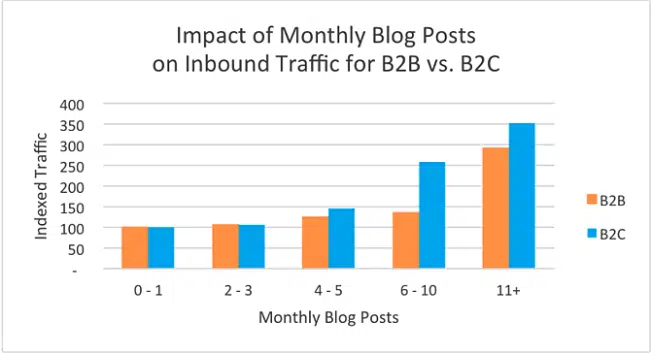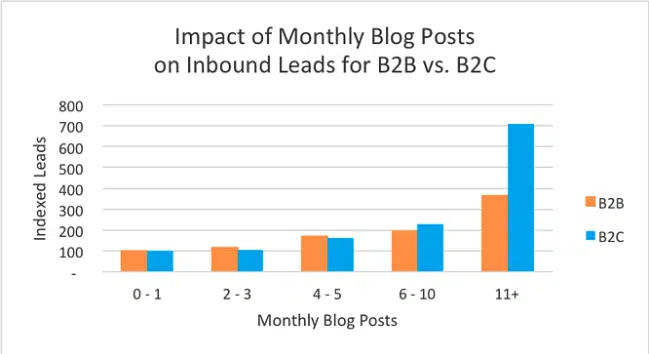The more you make yourself heard, the more opportunities for traffic and lead generation.
Often times, when meeting a new client and going through their needs, I find myself asking, “do you have an active blog?” Usually, the answer is somewhere between “kinda” and “not really.”
With so much else going on, businesses forget about a powerful tool they already have at their disposal, their blog. Strategic blogging will help increase your Google Ranking, increase traffic to your website, and generate inbound leads.
How blogging can grow your audience over time
In the inbound world, blogging helps attract new visitors to your site and simultaneously creates assets that can be shared across social media—bolstering your industry traffic levels (and your industry awareness).
How a blog can impact your Google rankings
Did you know that just having a blog on your site can improve your ranking by up to nearly 434%? Thats HUGE. Clearly, Google rewards sites that publish consistent informative content. By regularly posting useful content targeted to search topics important to your business, you can increase your search engine rankings.
Create trust & authority within your niche
Longer posts allow you to dig in and become a trusted authority on what your brand is most passionate about. Give your long form posts a little more umph, by doing the keyword research and creating a post that answers questions that may not have even been thought of yet. Be ahead of the game.
Blog posts also give businesses the opportunity to be found, heard and understood. Snack-able posts are a great way to share your company’s unique view on your industry, or quickly share a new product or service.
Never underestimate the power of internal links
Internal linking, whether that be to another page on your site or another blog post, encourage customers to explore your site. As a bonus, internal links also pass page authority, helping the linked page rank better.
A blog is the perfect place to anchor links to other links relevant to your post, allowing users the opportunity to see what else you have to offer. Read more about internal linking and other beginner SEO tips.
Consistent Blogging is Key
Ultimately, the quality of your content is just about as important as how often you post and update existing content. Balancing the relationship between frequency and quality can be tricky, but once it is found – you can become a blog content churning machine.
Powerup your SEO & Page Rankings
Search Engines, such as Google, use web-crawlers to index the growing number of websites that exist today. Search engine algorithms rank your site based on a variety of factors like relevancy, mobile friendliness, inbound links, authoritativeness and much more.
With that said, the more often you post, the more opportunities you have to strengthen your SEO and rank higher.
In tandem with building up your Search Engine rankings, blogging more could also lead inbound linking from other sources. Getting a reputable website to cite or repost your blog is a strong signal to search engines that the information on that page is credible.
Do Your Keyword Research Homework
What is blogging without using the right words? Understand out how they’re talking about what you’re selling by doing keyword research. When writing, keep those key phrases in mind, with your strongest ranking keyword phrases in your titles and headers.
Updating your blog frequently allows you to devote individual posts to a wide range of keywords to help users find you through a Google search or any search engine query. This also gives you the perfect chance to speak to a specific audience using specialized keywords (like local audiences) while maintaining the breadth of keywords you want to rank for.
The growth of voice search is creating longer, more conversational queries. Use a tool like keywordtool.io to uncover query language that can help optimize your content for voice search.
Create a Feasible Content Calendar to Start
Find somewhere to start! If you already have a blog, take an audit of what’s working and what is not – do some updating (Google loves that), identify gaps and topics you should or want to be a part of the conversation. Build out a monthly Editorial Calendar and take stock of your resources, writers, videographers, photographers, and so on.
Some companies may be stretched too thin to have this on one person – try to spread it out to get the whole company involved. Once you know how many writers you have and have identified the amount of time you have available – you can fill in your calendar with posts that should be updated or written. This will give you a better idea of where you can start and what to work towards. Other companies can dedicate a person or a team to this.
Either way – consistency and targeting your key phrases are imperative to the success and value of your post.
So – How Often Should Your Business be Blogging?
During the planning phase of your editorial calendar, you should keep in mind your specific purpose of your blog. Are you focused on traffic? Leads? Conversions? Everything you can scoop up along the way? That sounds crazy, but if you’re not sure who you’re talking to or what they want to hear from you – sometimes, this can give you a good place to look back at and decide how to move forward when you can review the analytics of your post.
If a post is doing well, you know you touched a nerve. If a post is dying, you may want to take a second look at it and then decide whether to nix it completely or simply update it with new information or keywords.
Our friends at Hubspot did some real digging into the correlation between the blogging consistency as it correlates to both traffic and leads, as well as company size.
Effect of Monthly Blogging Posts on Traffic
The short of it – Businesses that published at least 16 blogs or more per month saw almost 3x more traffic than those that only published between 0-4.
Here’s a glance at what they found:
| Company Size | 1-10 Employees | 11-25/201+ Employees | 26-200 Employees |
| # Posts/Mo. | 11+ blogs | 11+ | 11+ |
| Result | 3x More Traffic | 3.5x More Traffic | 2x More Traffic |
B2B vs B2C

B2C saw a positive, steady correlation between the number of posts and traffic, while B2B really only saw change at around 11+ per month – returning 3x more traffic than those not blogging at all. Makes sense when you think about everything we just went over, right?
Effect of Monthly Blogging Posts on Traffic
Hubspot found that consistent blog publishing does really have an effect on leads, however there is a slight divide by company size for both B2B & B2C.
Websites that published 16 blog posts or more received about 4x more leads than companies that published nearly none.
Take a look at what Hubspot found:
| Company Size | 1-10/11-25 Employees | 26-200 Employees | 200 Employees |
| Number of Posts Per Month | 11+ blogs | 11+ | 11+ |
| Effect on Traffic | 3x More Traffic | 3.5x More Traffic | 2x More Traffic |
B2C vs B2B

As you can see, B2C companies blogging 11+ times a month saw more that 4x as many leads than those that only published 4-5 times a month. While B2B saw a less pronounced difference at 1.7x in lead generation with 11 or more blogs per month, and received 3.75x more leads than those blogging 0-3x per month.
So, Does the Total Number of Blogs You Have Matter?
Surprise! It definitely does. Hubspot found that companies which had over 400 published blog posts received about twice as much traffic that has 300-400 published on site.
Overall, when you commit to blogging, you commit to the easiest (and cheapest) way to not only give your brand search engine authority – but keep your voice heard and in the conversation as well. Blogging is one of the easiest strategies out there to integrate into your current strategy through consistency and quality (yes, you do need both).
They tell you to write what you know, why not share it?
Keep bloggin’ on.
Source: HubSpot.com



